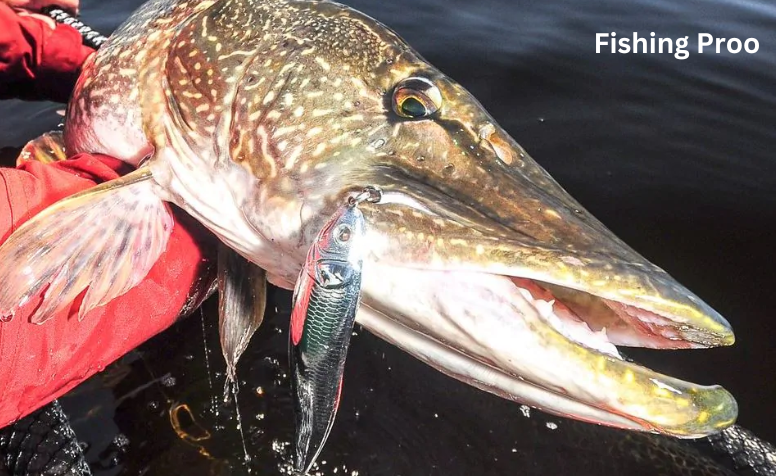Pike Fish
A species of carnivorous fish belonging to the genus Esox is the northern pike. In the Northern Hemisphere, they are typically found in freshwater environments with a moderate salt content. In Canada, the United States, Great Britain, Ireland, and most of Eastern Europe, they are simply referred to as pikes. Pike have a considerable potential for growth.
BEHAVIOUR OF PIKE FISH

AGGRESSION:
When it comes to feeding, the northern pike is a quite aggressive fish. For instance, in a tiny proportion of populations, cannibalism begins to emerge around the age of five weeks when food supplies become short. When there is a two-to-one predator to prey ratio, cannibalism takes place.
PHYSICAL TRAITS:
Pike have the ability to swim in abrupt, high-energy bursts known as “fast start” motions. This action is also exhibited by many other species. Most fish employ this defense system to stay out of potentially fatal circumstances. But for the pike, it’s a tool for catching prey while they’re inactive. In short bursts, they flash out and seize their prey. The pike reaches its top speed at which point these quick starts come to an end. Pike form “S” conformations while swimming quickly during such moves. They just adopt a “C” conformation to slow down, so exponentially decreasing their speed and enabling them to “stop”. The fact that pike have long eating periods and low digestion times is an intriguing behavioral characteristic. They are capable of multiple quick spurts in order to gather as much prey as possible. Pike activity is lowest at night.
- REPRODUCTION:
Because of their powerful homing instinct, pike are obligate residents of particular places. In contrast to the winter, they usually congregate nearer to plants in the summer. The precise cause is unknown, although it most likely stems from foraging or the desire to protect offspring during reproduction. The diel rhythm of pike varies dramatically throughout the year. Pike tend to stick closer to the shallow coast on bright days. They are further out from the coast on windy days. Pike favor shallow, forested areas when they are near the coast. Compared to lakes, reservoirs are more immobile home to pike. It’s possible that there is more food available in lakes for the pike to eat, or that in reservoirs, prey will eventually come into contact with the pike. Therefore, this might be a type of energy conservation.
FEEDING:
The juvenile, free-swimming pike initially consumes small invertebrates, such as Daphnia, before swiftly transitioning to larger targets, such Gammarus and Asellus. At a body length of 4 to 8 cm (1.6 to 3.1 in), they begin consuming tiny fish for food.
A pike’s hunting behavior is fairly typical; it uses its ability to move its pectoral and dorsal fins’ terminal rays to stay still in the water. It uses the broad surfaces of its anal, dorsal, and caudal fins to push itself before bending its body and darting out to strike the victim. When pursuing larger prey, the pike would typically try to drown it before bringing it off to be eaten. Pike primarily consumes fish and frogs, but it sometimes takes down small mammals and birds. Ted Hughes, a well-known English poet, made reference to the discovery that young pike had been found dead after choking on a pike of a similar size in his poem “Pike”. Moreover, leeches, crayfish, and insects are consumed by northern pike. They consume sticklebacks and other small fish if they are the sole available food. They are not picky eaters and will even consume perch and other spiky fish.
IMPORTANCE TO HUMANS
Despite being regarded as a “sporting” quarry, some anglers release pike they have caught because of the bony nature of the meat, particularly because of the large (epipleural) “Y-bones”. Nonetheless, pikes’ white, mild-tasting flesh has a long and illustrious culinary history and is a favorite dish in areas of North America and Europe. The ability of a filleter to efficiently remove the bones from the fillets while reducing the amount of flesh lost in the process—a procedure known as “de-boning”—is highly appreciated in fishing towns where pike is a favorite dish.
There are ways to fillet pike without removing the “y-bones” from the fish’s body; this approach leaves some flesh on the fish but does not involve the occasionally challenging “de-boning” procedure. While smaller fish are frequently processed as forcemeat to remove their numerous tiny bones and then used in preparations like quenelles and fish mousses, larger fish are easier to fillet and much easier to debone. Pike cooking is mentioned in history all the way back to the Roman era. Because of their forceful impacts and amazing airborne maneuvers, pike fishing is reputed to be extremely thrilling. One of the biggest freshwater game fish in North America is the pike
CONCLUSION
In Europe, pike angling is becoming a more and more popular past time. This hard-fighting fish can be caught with lure fishing, jerk baiting, and dead baiting. Because of their tenacious fighting, they are highly valued as game fish.
In the spring, when the large pike come into the shallows to spawn in weedy regions, shoreline pike fishing is particularly productive. Many of the pike stay in the shallows to feast on other spawning coarse fish species, which helps them recover from their spawning losses. For their own safety as well as the small fish food that is available there, smaller jack pike frequently stay in the shallows.
